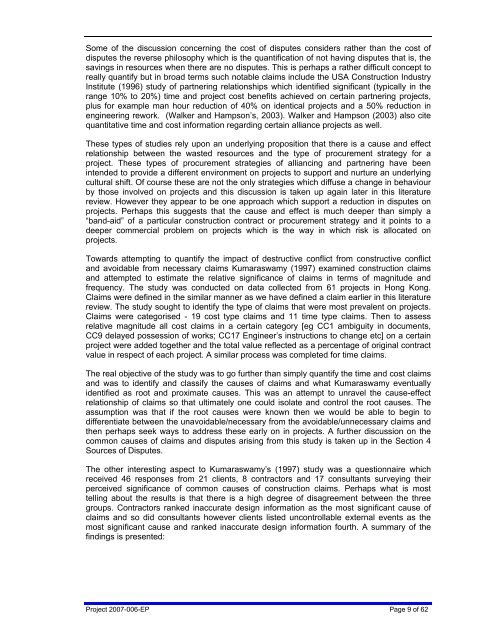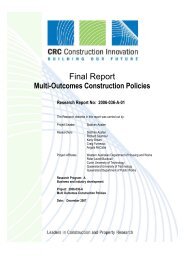Dispute Avoidance and Resolution (literature review) - Construction ...
Dispute Avoidance and Resolution (literature review) - Construction ...
Dispute Avoidance and Resolution (literature review) - Construction ...
Create successful ePaper yourself
Turn your PDF publications into a flip-book with our unique Google optimized e-Paper software.
Some of the discussion concerning the cost of disputes considers rather than the cost ofdisputes the reverse philosophy which is the quantification of not having disputes that is, thesavings in resources when there are no disputes. This is perhaps a rather difficult concept toreally quantify but in broad terms such notable claims include the USA <strong>Construction</strong> IndustryInstitute (1996) study of partnering relationships which identified significant (typically in therange 10% to 20%) time <strong>and</strong> project cost benefits achieved on certain partnering projects,plus for example man hour reduction of 40% on identical projects <strong>and</strong> a 50% reduction inengineering rework. (Walker <strong>and</strong> Hampson’s, 2003). Walker <strong>and</strong> Hampson (2003) also citequantitative time <strong>and</strong> cost information regarding certain alliance projects as well.These types of studies rely upon an underlying proposition that there is a cause <strong>and</strong> effectrelationship between the wasted resources <strong>and</strong> the type of procurement strategy for aproject. These types of procurement strategies of alliancing <strong>and</strong> partnering have beenintended to provide a different environment on projects to support <strong>and</strong> nurture an underlyingcultural shift. Of course these are not the only strategies which diffuse a change in behaviourby those involved on projects <strong>and</strong> this discussion is taken up again later in this <strong>literature</strong><strong>review</strong>. However they appear to be one approach which support a reduction in disputes onprojects. Perhaps this suggests that the cause <strong>and</strong> effect is much deeper than simply a“b<strong>and</strong>-aid” of a particular construction contract or procurement strategy <strong>and</strong> it points to adeeper commercial problem on projects which is the way in which risk is allocated onprojects.Towards attempting to quantify the impact of destructive conflict from constructive conflict<strong>and</strong> avoidable from necessary claims Kumaraswamy (1997) examined construction claims<strong>and</strong> attempted to estimate the relative significance of claims in terms of magnitude <strong>and</strong>frequency. The study was conducted on data collected from 61 projects in Hong Kong.Claims were defined in the similar manner as we have defined a claim earlier in this <strong>literature</strong><strong>review</strong>. The study sought to identify the type of claims that were most prevalent on projects.Claims were categorised - 19 cost type claims <strong>and</strong> 11 time type claims. Then to assessrelative magnitude all cost claims in a certain category [eg CC1 ambiguity in documents,CC9 delayed possession of works; CC17 Engineer’s instructions to change etc] on a certainproject were added together <strong>and</strong> the total value reflected as a percentage of original contractvalue in respect of each project. A similar process was completed for time claims.The real objective of the study was to go further than simply quantify the time <strong>and</strong> cost claims<strong>and</strong> was to identify <strong>and</strong> classify the causes of claims <strong>and</strong> what Kumaraswamy eventuallyidentified as root <strong>and</strong> proximate causes. This was an attempt to unravel the cause-effectrelationship of claims so that ultimately one could isolate <strong>and</strong> control the root causes. Theassumption was that if the root causes were known then we would be able to begin todifferentiate between the unavoidable/necessary from the avoidable/unnecessary claims <strong>and</strong>then perhaps seek ways to address these early on in projects. A further discussion on thecommon causes of claims <strong>and</strong> disputes arising from this study is taken up in the Section 4Sources of <strong>Dispute</strong>s.The other interesting aspect to Kumaraswamy’s (1997) study was a questionnaire whichreceived 46 responses from 21 clients, 8 contractors <strong>and</strong> 17 consultants surveying theirperceived significance of common causes of construction claims. Perhaps what is mosttelling about the results is that there is a high degree of disagreement between the threegroups. Contractors ranked inaccurate design information as the most significant cause ofclaims <strong>and</strong> so did consultants however clients listed uncontrollable external events as themost significant cause <strong>and</strong> ranked inaccurate design information fourth. A summary of thefindings is presented:Project 2007-006-EP Page 9 of 62
















